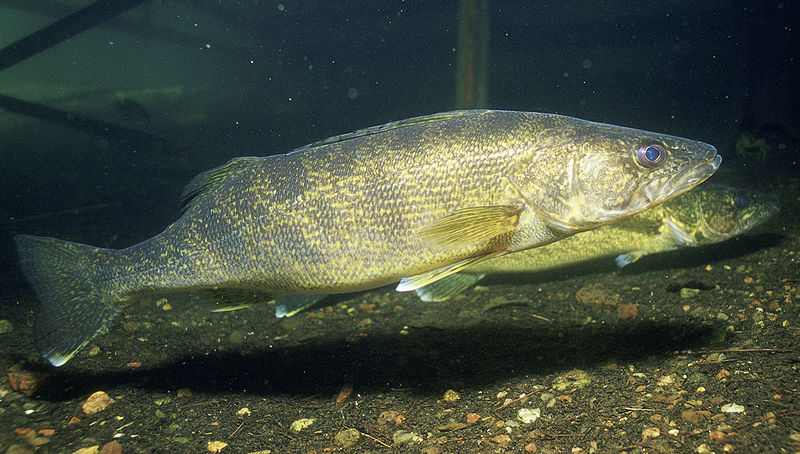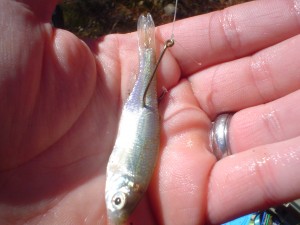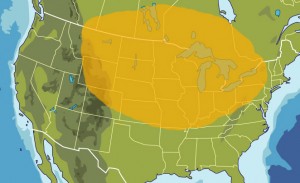Overview of Walleye’s Habitat and Physical Features
Walleye’s get their name for their catlike eyes that have high reflectivity when a light is shined at them. These eyes which are equipped with numerous rods and cones much like the human eye can Pearce through dark or cloudy water with ease. Their eye is structured in a way that allows them to see better from below than from above, which makes it easier for them to ambush their next meal. Their eyes are fairly large in porpotion to the rest of their head. It is these eyes that allow them to perform much of their feeding at night or in low light conditions. Early morning, dusk or overcast days with rough water make ideal Walleye fishing days.
They have a greenish to yellow skin color with two sets of dorsal fins the first resembling that almost of a striped bass with needle sharp dorsal spikes. Their underbellies are almost pure white with a pair of pectoral fins that are generally a shade of yellow. A broad tail for use with quick lunges or fast getaways is also a characteristic of the fish. A Walley’s mouth is equipped with numerous sharp teeth used to grasp their prey which is generally swallowed head first. Be careful of your fingers as the teeth of a larger Walleye can easily puncture skin. Numerous anglers will head out on rough weather days to capitalize on the feeding habits of the Walleye, which is generally more active on more turbulant days. They prefer somewhat cooler waters so on warmer days you will find them in the deeper sections of the lake or pond. During the early spring when the spawn you can find them closer to the shallows looking to head up streams. Generally the largest that they will grow is 3 feet long weighing no more than 20lbs. However on rare occasions larger Walleye have been caught. The longest lifespan for walleye is around 25 years, but many do not make it to this ripe old age due to other predators or anglers. Like many other species like Large-mouth Bass or Trout the Walleye when it is still a fry will feed on microorganisms and larvae insects until they are old enough to hunt for minnows, Perch or Bluegills.
The Walleye is equipped with a variety of senses many of which are used to catch their next meal. Their vision is considered one of the best of the sports fish, their sense of taste and smell is also quite powerful. The walleyes sense of smell however falls short compared to that of the catfish which is about four times as powerful. The length of the Walleye also plays a key role as it is another fish that is equipped with the lateral line system which is used to pick up vibrations in the water. Northern Pike and other predators that have long bodies use this system to detect and locate their prey based on vibrations felt in the water.
They are known to have a very selective diet at times only preying on fish that are abundant at the time. Many anglers who study the feeding habits of the Walleye know the exact bait to use for the time of the season so be sure to talk to the locals. When Walley’s are feeding on Perch they would probably not be interested in the yellow plastic worm you are dangling in front of their face.
Before I head out Walleye fishing I fish for a few hours catching Perch to use as bait. This ensures that I am using what they are naturally feeding on. Here are some Perch fishing tips that will help you land some baitfish while Walleye fishing.
Some species that they feed on throughout the course of a year are Minnows, Perch, Alewives and Shinners, but further south away from the Great Lakes region they are known the feed on Sunfish and Bluegills.
How to catch Walleye
There are a variety of methods to catch Walleye. I will highlight a few of the most popular methods. One technique that is very popular is to use a jig with live bait. Anglers will use a orange or yellow fireball jig and bait it with a shiner through its mouth and out its back. This method unfortunately cripples the bait, but capitalizes on the Walley’s sense of vision and smell. This is a good method to use for deeper water fishing. Another method is simply to use an eagle claw or similar hook and attach a shiner through its dorsal fine to the hook. This keeps the shiner alive longer and the Walleye is able to locate the bait using its lateral line system. Depending on the conditions and temperature of the water you should use your own judgment as to what method would work better for that day.
Walleye are also caught on artificial plus. Smaller yellow deep diving plugs that do not float to the top while stopped work well when you know that the walleye are down deep. Bright Yellow Plastic worms with a fireball jig also work well in some conditions. Spinner bait and spoons have also been known to produce good results. Be sure to use the right colors at the correct depths. Read our article “What color fishing lure should I use?” for a detailed description. Drifting for Walleye generally produces better results than anchored as they are know to stay rather still at times, especially during cooler conditions. Making a very slow drift over a drop off or deeper water while jigging off of the bottom will produce results over time. Be patient as sometimes it takes a few hours to find out where the fish are located. A good depth finder is an essential tool to finding a school of larger Walleye.
Where to Catch Walleye
The great lakes region is a very popular location to catch Walleye. They are generally located in the Upper to Midwest areas of the united states and Canada. Seek out the larger lakes with decent depths as this is where you will find the larger Walleyes during the summer. Stay closer to the shoreline in the spring as they will be spawning at that time and will be looking for their meals much closer to the surface. Below are some locations where you can
find Walleye
- Great Lakes Region
- Michigan
- Lake Erie
- Lake Huron
- Lake Michigan
- Houghton Lake
- Lake Saint Helen
- Canada
- Lake Simcoe
- Lake Manitoba
- New York State
- Lake Ontario
- Wisconsin
- Lake Winnebago
- Lake Mendota
- Lake KoshKonong
- Grindstone Lake
- Stone Lake
- Sand Lake
- Whitefish Lake
- Minnesota
- Mille Lacs Lake
- Upper Red Lake
- Lower Red Lake
- Traders Bay
- Sucker Bay
- Tenmile Lake
- Mile Lacs Lake
- Montana
- Lake Fort Peck
 Walleye Fishing Tips
Walleye Fishing Tips
Head out on choppy overcast days in the later spring. Look for depths 20 feet of deeper while large drop-offs or Rocky bottom where they can find cover to ambush their prey. Like many fish they will stay in areas where they can conserve most of their energy while having a good vantage point for their next meal to swim by. Understand what they are feeding on at the time of year you are fishing, this is key to landing larger Walleye.



